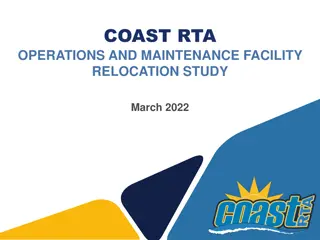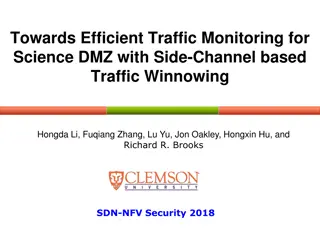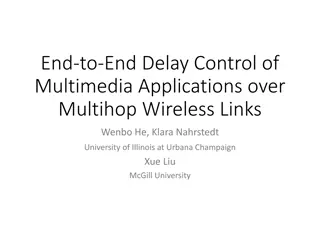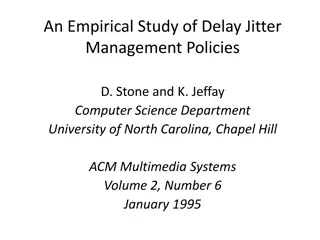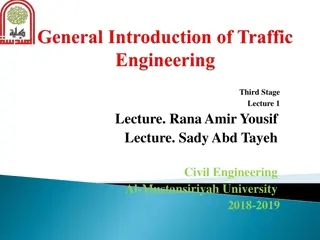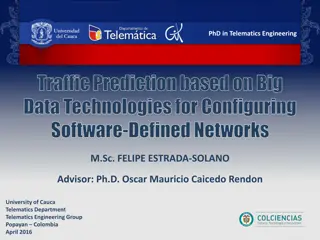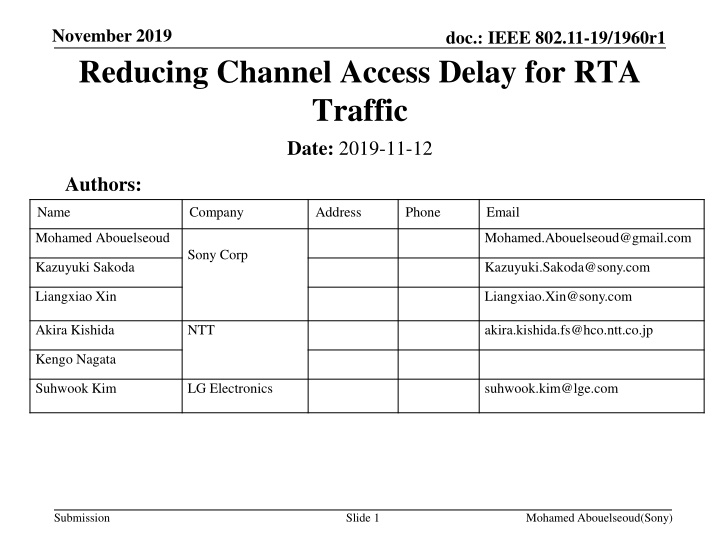
Reducing Channel Access Delay for RTA Traffic Analysis
Explore methods to reduce channel access delay for real-time application (RTA) traffic, focusing on components affecting packet latency. The study addresses the challenges in managing large and small size RTA traffic with different frequencies and suggests enhancements to existing technologies for improved performance.
Download Presentation

Please find below an Image/Link to download the presentation.
The content on the website is provided AS IS for your information and personal use only. It may not be sold, licensed, or shared on other websites without obtaining consent from the author. If you encounter any issues during the download, it is possible that the publisher has removed the file from their server.
You are allowed to download the files provided on this website for personal or commercial use, subject to the condition that they are used lawfully. All files are the property of their respective owners.
The content on the website is provided AS IS for your information and personal use only. It may not be sold, licensed, or shared on other websites without obtaining consent from the author.
E N D
Presentation Transcript
November 2019 Reducing Channel Access Delay for RTA Traffic Date: 2019-11-12 doc.: IEEE 802.11-19/1960r1 Authors: Name Company Address Phone Email Mohamed Abouelseoud Mohamed.Abouelseoud@gmail.com Sony Corp Kazuyuki Sakoda Kazuyuki.Sakoda@sony.com Liangxiao Xin Liangxiao.Xin@sony.com Akira Kishida NTT akira.kishida.fs@hco.ntt.co.jp Kengo Nagata Suhwook Kim LG Electronics suhwook.kim@lge.com Submission Slide 1 Mohamed Abouelseoud(Sony)
November 2019 doc.: IEEE 802.11-19/1960r1 Background 802.11be is targeting technologies to limit worst case latency and jitter [1] Current EDCA cannot solve the problem of worst case latency EDCA is designed to provide good average latency (AC queues access probability and STA access probability may lead to worst case latency) MU UL and DL transmission enable serving more users at the same time which can help with latency, channel access delay is still a problem Using Multi-link/Multi-channel to improve latency is proposed in [2],[3],[4] There is an overhead in scheduling small amount of data especially in periodic and persistent traffic Enhancement to trigger-based access and use of RU allocation configuration is proposed in [5] Persistent RU allocation is proposed in [6] Submission Slide 2 Mohamed Abouelseoud(Sony)
November 2019 doc.: IEEE 802.11-19/1960r1 RTA traffic analysis RTA traffic can be:[7] Large in size and frequent ( interactive video (VR, AR), Medical application, Real time video, ) Large in size and less frequent ( Emergency service,..) Small in size and frequent ( mobile gaming, robotics and industrial automation, cloud gaming, drone control, ) Small in size and less frequent (controllers, IoT, .) Small in size RTA traffic should be specially treated without affecting ongoing traffic Frequent and periodic traffic can be expected and prepared for Large in size RTA traffic that is less frequent can be handled but will affect ongoing traffic Large in size RTA traffic that is frequent might be harder to satisfy in lower band due to bandwidth limitation (mmW might be a candidate) Slide 3 Submission Mohamed Abouelseoud(Sony)
November 2019 doc.: IEEE 802.11-19/1960r1 Packet delay components In [8], for EDCA packet latency has been broken into various components: Queuing delay (Tw): Time waiting in the transmitter s queue Contention delay (Tc): Time to gain initial channel access Retransmission time (TR): Time to recover from a transmission failure Transmission time (TTX): Time to transmit the packet till an ack is received In order to limit worst case delay and jitter we should consider limiting all components of the packet delay Submission Slide 4 Mohamed Abouelseoud(Sony)
November 2019 doc.: IEEE 802.11-19/1960r1 How to handle small frequent RTA traffic? RTA Pk length RTA Pk length RTA Pk length RTA Pk length Assuming traffic is periodic for frequent/persistent traffic allows us to limit maximum latency constraint Allocating small periodic resources to RTA traffic Use persistent/configuration based RU allocation to allocate resources When traffic is persistent, frequent or periodic, AP/STA can know and estimate when the RTA packet will be ready to be transmitted (UL or DL) Persistent channel allocation can help by allocating resource for transmission but channel access delay still contributes to the RTA packet delay RTA Pk period RTA Pk period RTA Pk period RTA Packet Arrival RTA Packet Arrival RTA Packet Arrival RTA Packet Arrival Persistent channel allocation Maximum delay Channel access Maximum delay Channel Maximum delay Channel access Channel access access Persistent channel allocation and channel access delay Channel access delay Channel access delay Channel access delay RTA Packet transmission Channel busy Back-off Submission Slide 5 Mohamed Abouelseoud(Sony)
November 2019 doc.: IEEE 802.11-19/1960r1 RTA small in size and frequent traffic Proposal: Small and periodic RTA traffic can be expected and STAs can prepare for channel access before its arrival Submission Slide 6 Mohamed Abouelseoud(Sony)
November 2019 Proposal: How to reduce or avoid channel access delay for RTA traffic ? doc.: IEEE 802.11-19/1960r1 Assuming Queuing delay and retransmission delay are zero RTA packet arrival Once the RTA packet is queued, knowing the RTA packet generation periodicity or the RU allocation periodicity, the STA can estimate when the next packet will arrive or will be sent When the STA is aware of the expected arrival time of the RTA packet, it can have the option to contend for channel access before the packet arrival in case the channel is busy When the STA gains access of the channel: If RTA packet is queued, STA transmits the RTA packet If RTA packet is not yet queued and the time to the expected arrival time of the packet is small, the STA can reserve the channel ( example: sending null packet till the expected RTA packet arrival) If RTA packet is not yet queued and the time to the expected arrival time of the packet is large, the STA does not reserve the channel B- off RTA PK Tx Busy Channel access delay Expected RTA packet arrival Start contention early B- off RTA PK Tx Busy Channel access delay Submission Slide 7 Mohamed Abouelseoud(Sony)
November 2019 Proposal: examples of pre-packet arrival channel contention Before the arrival of the RTA packet or the allocated time for RTA transmission by Early CW period , The STA monitors the channel If the channel is busy during this time, STA contends for channel access If the channel is not busy, the STA keeps monitoring the status of the channel. If the channel gets busy before the packet arrival, the STA contends for channel access The STA might gain access to the channel even before the RTA packet arrival by early channel access period and reserves the channel (sends null packets) till the expected RTA packet arrival. doc.: IEEE 802.11-19/1960r1 RTA Packet Arrival Pre-Pk arrival Channel sensing Early CW period Early Channel access period Ch Res RTA Pk Busy Back off Channel free Monitor the channel in case it gets busy RTA Packet Arrival Pre-Pk arrival Channel sensing Early CW period Early Channel access period Ch Res RTA Pk Busy Back off Monitor the channel in case it gets busy RTA Packet Arrival Pre-Pk arrival Channel sensing Early CW period Early Channel access period RTA Pk Busy Back off Monitor the channel in case it gets busy Submission Slide 8 Mohamed Abouelseoud(Sony)
November 2019 doc.: IEEE 802.11-19/1960r1 Summary Minimizing channel access delay is important to limit the worst case latency and jitter over WLAN For frequent RTA traffic, persistent resource allocation can help in limiting worst case latency and jitter For small and periodic RTA traffic, the STA knowing the expected time of RTA packets arrival can limit the channel access delay by contending for channel access before the expected arrival of the RTA packet Submission Slide 9 Mohamed Abouelseoud(Sony)
November 2019 doc.: IEEE 802.11-19/1960r1 Reference 1) 2) 802.11-18/1231r6 EHC draft proposed PAR, Laurent Cariou 802.11-19/1615r0, Multi-band/Multi-channel Operation for Low Latency and Jitter, Liuming Lu, et.al. 802.11-19/1081r1, Multi-Link Aggregation: Latency Gains, Abhishek Patil, et.al. 802.11-19/1223r0, Improving WLAN reliability, Antonio del la Oliva, et.al. 802.11-19/1118r1, Enhancements for Time-Critical Data Transmission Thomas Handte, et.al. 802.11-19/1538r1 Use of Uplink Persistent Allocation for RTA, Xin Zuo, et.al. 802.11-19/1175r0 Considerations of New Queue Mechanism for Real-Time Application Xin Zuo, et.al. 802.11-19/0762r1 Latency analysis for EHT Suhwook Kim, et. al. 3) 4) 5) 6) 7) 8) Submission Slide 10 Mohamed Abouelseoud(Sony)







